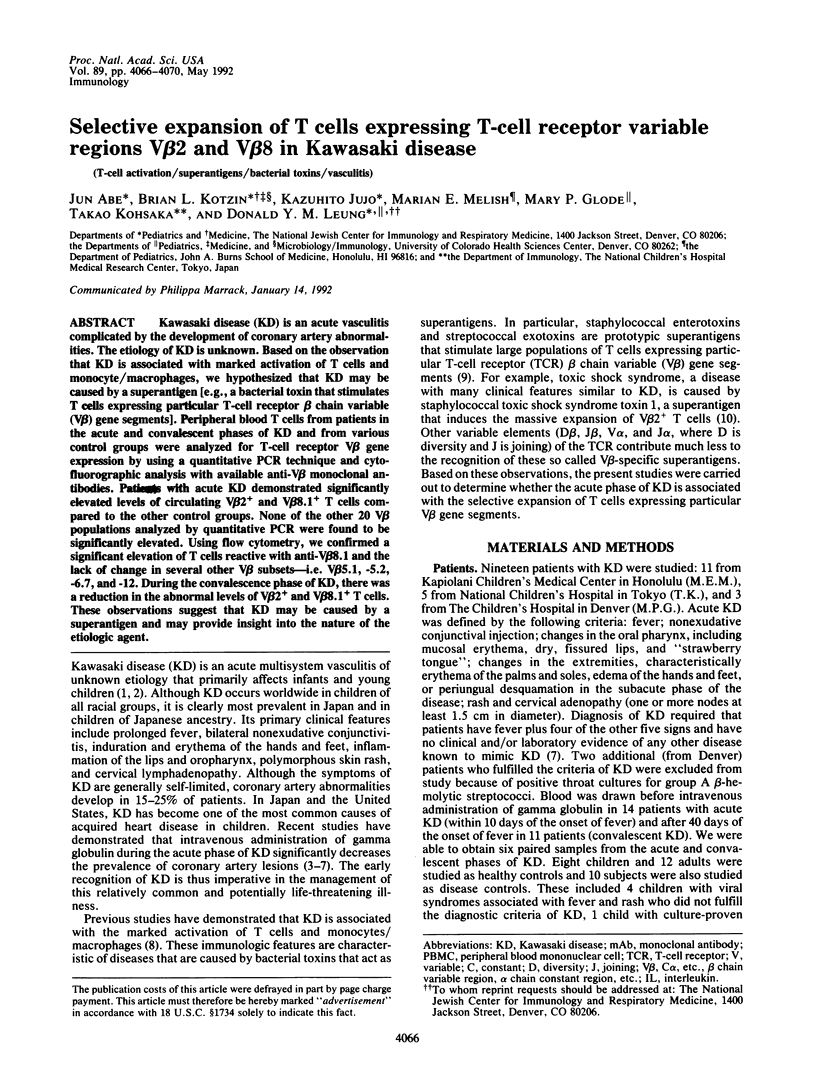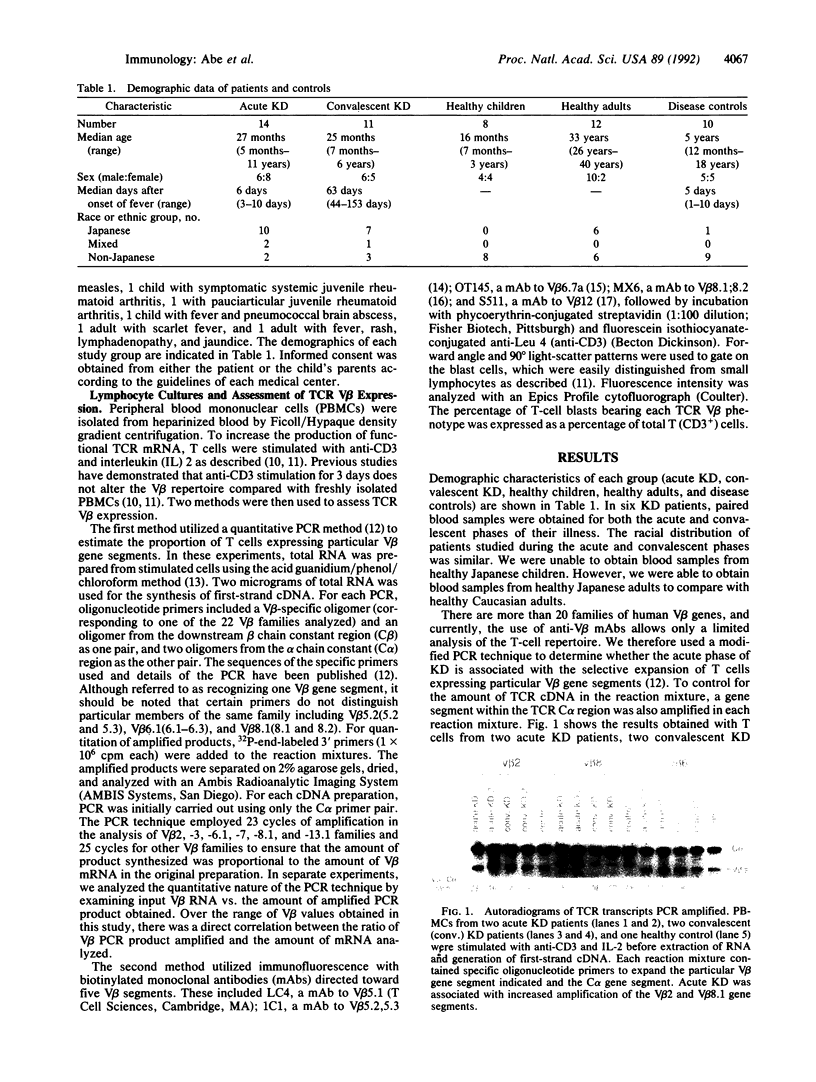Abstract
Kawasaki disease (KD) is an acute vasculitis complicated by the development of coronary artery abnormalities. The etiology of KD is unknown. Based on the observation that KD is associated with marked activation of T cells and monocyte/macrophages, we hypothesized that KD may be caused by a superantigen [e.g., a bacterial toxin that stimulates T cells expressing particular T-cell receptor beta chain variable (V beta) gene segments]. Peripheral blood T cells from patients in the acute and convalescent phases of KD and from various control groups were analyzed for T-cell receptor V beta gene expression by using a quantitative PCR technique and cytofluorographic analysis with available anti-V beta monoclonal antibodies. Patients with acute KD demonstrated significantly elevated levels of circulating V beta 2+ and V beta 8.1+ T cells compared to the other control groups. none of the other 20 V beta populations analyzed by quantitative PCR were found to be significantly elevated. Using flow cytometry, we confirmed a significant elevation of T cells reactive with anti-V beta 8.1 and the lack of change in several other V beta subsets--i.e. V beta 5.1, -5.2, -6.7, and -12. During the convalescence phase of KD, there was a reduction in the abnormal levels of V beta 2+ and V beta 8.1+ T cells. These observations suggest that KD may be caused by a superantigen and may provide insight into the nature of the etiologic agent.
Full text
PDF




Images in this article
Selected References
These references are in PubMed. This may not be the complete list of references from this article.
- Abe J., Forrester J., Nakahara T., Lafferty J. A., Kotzin B. L., Leung D. Y. Selective stimulation of human T cells with streptococcal erythrogenic toxins A and B. J Immunol. 1991 Jun 1;146(11):3747–3750. [PubMed] [Google Scholar]
- Abe Y., Nakano S., Nakahara T., Kamezawa Y., Kato I., Ushijima H., Yoshino K., Ito S., Noma S., Okitsu S. Detection of serum antibody by the antimitogen assay against streptococcal erythrogenic toxins. Age distribution in children and the relation to Kawasaki disease. Pediatr Res. 1990 Jan;27(1):11–15. doi: 10.1203/00006450-199001000-00003. [DOI] [PubMed] [Google Scholar]
- Bigler R. D., Fisher D. E., Wang C. Y., Rinnooy Kan E. A., Kunkel H. G. Idiotype-like molecules on cells of a human T cell leukemia. J Exp Med. 1983 Sep 1;158(3):1000–1005. doi: 10.1084/jem.158.3.1000. [DOI] [PMC free article] [PubMed] [Google Scholar]
- Carrel S., Isler P., Schreyer M., Vacca A., Salvi S., Giuffre L., Mach J. P. Expression on human thymocytes of the idiotypic structures (Ti) from two leukemia T cell lines Jurkat and HPB-ALL. Eur J Immunol. 1986 Jun;16(6):649–652. doi: 10.1002/eji.1830160610. [DOI] [PubMed] [Google Scholar]
- Choi Y. W., Kotzin B., Herron L., Callahan J., Marrack P., Kappler J. Interaction of Staphylococcus aureus toxin "superantigens" with human T cells. Proc Natl Acad Sci U S A. 1989 Nov;86(22):8941–8945. doi: 10.1073/pnas.86.22.8941. [DOI] [PMC free article] [PubMed] [Google Scholar]
- Choi Y., Lafferty J. A., Clements J. R., Todd J. K., Gelfand E. W., Kappler J., Marrack P., Kotzin B. L. Selective expansion of T cells expressing V beta 2 in toxic shock syndrome. J Exp Med. 1990 Sep 1;172(3):981–984. doi: 10.1084/jem.172.3.981. [DOI] [PMC free article] [PubMed] [Google Scholar]
- Chomczynski P., Sacchi N. Single-step method of RNA isolation by acid guanidinium thiocyanate-phenol-chloroform extraction. Anal Biochem. 1987 Apr;162(1):156–159. doi: 10.1006/abio.1987.9999. [DOI] [PubMed] [Google Scholar]
- Fast D. J., Schlievert P. M., Nelson R. D. Toxic shock syndrome-associated staphylococcal and streptococcal pyrogenic toxins are potent inducers of tumor necrosis factor production. Infect Immun. 1989 Jan;57(1):291–294. doi: 10.1128/iai.57.1.291-294.1989. [DOI] [PMC free article] [PubMed] [Google Scholar]
- Furusho K., Kamiya T., Nakano H., Kiyosawa N., Shinomiya K., Hayashidera T., Tamura T., Hirose O., Manabe Y., Yokoyama T. High-dose intravenous gammaglobulin for Kawasaki disease. Lancet. 1984 Nov 10;2(8411):1055–1058. doi: 10.1016/s0140-6736(84)91504-6. [DOI] [PubMed] [Google Scholar]
- Kappler J., Kotzin B., Herron L., Gelfand E. W., Bigler R. D., Boylston A., Carrel S., Posnett D. N., Choi Y., Marrack P. V beta-specific stimulation of human T cells by staphylococcal toxins. Science. 1989 May 19;244(4906):811–813. doi: 10.1126/science.2524876. [DOI] [PubMed] [Google Scholar]
- Kawasaki T. [Acute febrile mucocutaneous syndrome with lymphoid involvement with specific desquamation of the fingers and toes in children]. Arerugi. 1967 Mar;16(3):178–222. [PubMed] [Google Scholar]
- Lang B. A., Silverman E. D., Laxer R. M., Lau A. S. Spontaneous tumor necrosis factor production in Kawasaki disease. J Pediatr. 1989 Dec;115(6):939–943. doi: 10.1016/s0022-3476(89)80746-2. [DOI] [PubMed] [Google Scholar]
- Lang B. A., Silverman E. D., Laxer R. M., Rose V., Nelson D. L., Rubin L. A. Serum-soluble interleukin-2 receptor levels in Kawasaki disease. J Pediatr. 1990 Apr;116(4):592–596. doi: 10.1016/s0022-3476(05)81610-5. [DOI] [PubMed] [Google Scholar]
- Leung D. Y., Burns J. C., Newburger J. W., Geha R. S. Reversal of lymphocyte activation in vivo in the Kawasaki syndrome by intravenous gammaglobulin. J Clin Invest. 1987 Feb;79(2):468–472. doi: 10.1172/JCI112835. [DOI] [PMC free article] [PubMed] [Google Scholar]
- Leung D. Y., Collins T., Lapierre L. A., Geha R. S., Pober J. S. Immunoglobulin M antibodies present in the acute phase of Kawasaki syndrome lyse cultured vascular endothelial cells stimulated by gamma interferon. J Clin Invest. 1986 May;77(5):1428–1435. doi: 10.1172/JCI112454. [DOI] [PMC free article] [PubMed] [Google Scholar]
- Leung D. Y., Cotran R. S., Kurt-Jones E., Burns J. C., Newburger J. W., Pober J. S. Endothelial cell activation and high interleukin-1 secretion in the pathogenesis of acute Kawasaki disease. Lancet. 1989 Dec 2;2(8675):1298–1302. doi: 10.1016/s0140-6736(89)91910-7. [DOI] [PubMed] [Google Scholar]
- Leung D. Y., Geha R. S., Newburger J. W., Burns J. C., Fiers W., Lapierre L. A., Pober J. S. Two monokines, interleukin 1 and tumor necrosis factor, render cultured vascular endothelial cells susceptible to lysis by antibodies circulating during Kawasaki syndrome. J Exp Med. 1986 Dec 1;164(6):1958–1972. doi: 10.1084/jem.164.6.1958. [DOI] [PMC free article] [PubMed] [Google Scholar]
- Leung D. Y. Immunologic aspects of Kawasaki syndrome. J Rheumatol Suppl. 1990 Sep;24:15–18. [PubMed] [Google Scholar]
- Mantovani A., Dejana E. Cytokines as communication signals between leukocytes and endothelial cells. Immunol Today. 1989 Nov;10(11):370–375. doi: 10.1016/0167-5699(89)90270-3. [DOI] [PubMed] [Google Scholar]
- Marrack P., Kappler J. The staphylococcal enterotoxins and their relatives. Science. 1990 May 11;248(4956):705–711. doi: 10.1126/science.2185544. [DOI] [PubMed] [Google Scholar]
- Matsubara T., Furukawa S., Yabuta K. Serum levels of tumor necrosis factor, interleukin 2 receptor, and interferon-gamma in Kawasaki disease involved coronary-artery lesions. Clin Immunol Immunopathol. 1990 Jul;56(1):29–36. doi: 10.1016/0090-1229(90)90166-n. [DOI] [PubMed] [Google Scholar]
- Maury C. P., Salo E., Pelkonen P. Elevated circulating tumor necrosis factor-alpha in patients with Kawasaki disease. J Lab Clin Med. 1989 May;113(5):651–654. [PubMed] [Google Scholar]
- Nagashima M., Matsushima M., Matsuoka H., Ogawa A., Okumura N. High-dose gammaglobulin therapy for Kawasaki disease. J Pediatr. 1987 May;110(5):710–712. doi: 10.1016/s0022-3476(87)80007-0. [DOI] [PubMed] [Google Scholar]
- Newburger J. W., Takahashi M., Beiser A. S., Burns J. C., Bastian J., Chung K. J., Colan S. D., Duffy C. E., Fulton D. R., Glode M. P. A single intravenous infusion of gamma globulin as compared with four infusions in the treatment of acute Kawasaki syndrome. N Engl J Med. 1991 Jun 6;324(23):1633–1639. doi: 10.1056/NEJM199106063242305. [DOI] [PubMed] [Google Scholar]
- Newburger J. W., Takahashi M., Burns J. C., Beiser A. S., Chung K. J., Duffy C. E., Glode M. P., Mason W. H., Reddy V., Sanders S. P. The treatment of Kawasaki syndrome with intravenous gamma globulin. N Engl J Med. 1986 Aug 7;315(6):341–347. doi: 10.1056/NEJM198608073150601. [DOI] [PubMed] [Google Scholar]
- Posnett D. N., Wang C. Y., Friedman S. M. Inherited polymorphism of the human T-cell antigen receptor detected by a monoclonal antibody. Proc Natl Acad Sci U S A. 1986 Oct;83(20):7888–7892. doi: 10.1073/pnas.83.20.7888. [DOI] [PMC free article] [PubMed] [Google Scholar]
- Rauch A. M., Hurwitz E. S. Centers for Disease Control (CDC) case definition for Kawasaki syndrome. Pediatr Infect Dis. 1985 Nov-Dec;4(6):702–703. doi: 10.1097/00006454-198511000-00029. [DOI] [PubMed] [Google Scholar]
- Rauch A. M. Kawasaki syndrome: review of new epidemiologic and laboratory developments. Pediatr Infect Dis J. 1987 Nov;6(11):1016–1021. [PubMed] [Google Scholar]
- Rowley A. H., Duffy C. E., Shulman S. T. Prevention of giant coronary artery aneurysms in Kawasaki disease by intravenous gamma globulin therapy. J Pediatr. 1988 Aug;113(2):290–294. doi: 10.1016/s0022-3476(88)80267-1. [DOI] [PubMed] [Google Scholar]
- Rowley A. H., Shulman S. T., Preble O. T., Poiesz B. J., Ehrlich G. D., Sullivan J. R. Serum interferon concentrations and retroviral serology in Kawasaki syndrome. Pediatr Infect Dis J. 1988 Sep;7(9):663–666. [PubMed] [Google Scholar]
- Terai M., Kohno Y., Namba M., Umemiya T., Niwa K., Nakajima H., Mikata A. Class II major histocompatibility antigen expression on coronary arterial endothelium in a patient with Kawasaki disease. Hum Pathol. 1990 Feb;21(2):231–234. doi: 10.1016/0046-8177(90)90135-r. [DOI] [PubMed] [Google Scholar]
- Ueno Y., Takano N., Kanegane H., Yokoi T., Yachie A., Miyawaki T., Taniguchi N. The acute phase nature of interleukin 6: studies in Kawasaki disease and other febrile illnesses. Clin Exp Immunol. 1989 Jun;76(3):337–342. [PMC free article] [PubMed] [Google Scholar]
- Yssel H., Blanchard D., Boylston A., De Vries J. E., Spits H. T cell clones which share T cell receptor epitopes differ in phenotype, function and specificity. Eur J Immunol. 1986 Oct;16(10):1187–1193. doi: 10.1002/eji.1830161002. [DOI] [PubMed] [Google Scholar]






